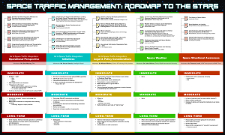Location
Jim Henderson Welcome Center, Embry-Riddle Aeronautical University - Daytona Beach
Start Date
6-11-2014 1:30 PM
Abstract
A viable space traffic management program faces a great barrier caused by the ever-increasing number and variety of orbiting objects ranging in size from a few microns to several meters. Although several international agreements to limit the growth rate of orbital debris are in place, the risk of damage and destruction to active satellites is continually rising. The urgency of this situation was highlighted by the 2007 Chinese ASAT test and the collision of Iridium and Cosmos satellites in 2009. Although many debris removal techniques have been posited none have been implemented. Unless a space debris reduction program is undertaken in the near future, continued access to space and use of space for applications and exploration may be extremely compromised. The growing collision threat will continue to complicate any future space traffic management program. Space junk is a man-made, growing threat to space-based applications such as communications, weather forecasting and Earth observation among many others. Space commerce is expanding and as this industry grows the need for an effective traffic management system will become critical to commercial growth and exploration of space. An integrated approach to resolving the debris issues through a carefully designed research program is described. Such a program could facilitate resolution of orbital debris impediments to a controlled space environment.
Area of Interest
Space Situational Awareness
Debris Research
An Integrated Approach to Orbital Debris Research and Management
Jim Henderson Welcome Center, Embry-Riddle Aeronautical University - Daytona Beach
A viable space traffic management program faces a great barrier caused by the ever-increasing number and variety of orbiting objects ranging in size from a few microns to several meters. Although several international agreements to limit the growth rate of orbital debris are in place, the risk of damage and destruction to active satellites is continually rising. The urgency of this situation was highlighted by the 2007 Chinese ASAT test and the collision of Iridium and Cosmos satellites in 2009. Although many debris removal techniques have been posited none have been implemented. Unless a space debris reduction program is undertaken in the near future, continued access to space and use of space for applications and exploration may be extremely compromised. The growing collision threat will continue to complicate any future space traffic management program. Space junk is a man-made, growing threat to space-based applications such as communications, weather forecasting and Earth observation among many others. Space commerce is expanding and as this industry grows the need for an effective traffic management system will become critical to commercial growth and exploration of space. An integrated approach to resolving the debris issues through a carefully designed research program is described. Such a program could facilitate resolution of orbital debris impediments to a controlled space environment.



Comments
Click here for Marshall Kaplan’s Bio Page